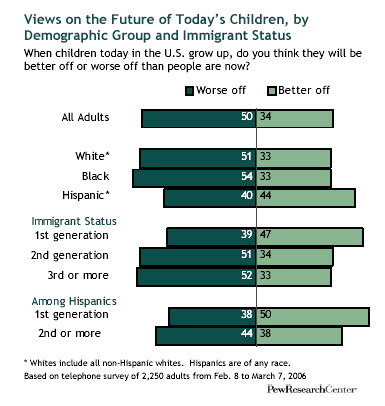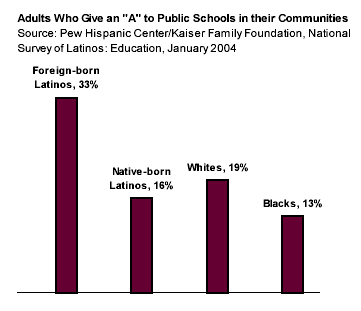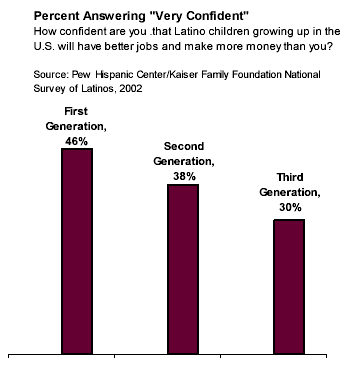by Gabriel Escobar
An adult Latino immigrant to this country is probably employed, probably religious, probably getting by without much money or education, and probably….an optimist. While all these characteristics are routinely confirmed by surveys, the rosy outlook might surprise people who look at the tough life of the immigrant from the outside and see little cause for optimism.

But Hispanics in general, and Hispanic immigrants in particular, are more inclined than blacks or whites to take an upbeat view about one of the most enduring tenets of the American dream — the idea that each generation will do better in life than the one that preceded it.
Some 44% of all Hispanic adults — and fully half of all first-generation Hispanic immigrants — say that today’s children in this country will grow up to be better off than people are now, according to a recent Pew Research Center survey. By contrast, just 33% of both whites and black hold this positive view.
This relative optimism among Hispanics is even more notable because as a group they express less satisfaction with the quality of their own lives today (64% say it’s good or excellent) than do either whites (86% good or excellent) or blacks (76% good or excellent). One reason for the disparity in current satisfaction may be the relatively low weekly earnings of Hispanics in the U.S., which average only about two-thirds of weekly earnings among non-Hispanic Americans. Another might be their relative lack of education; 40% of Hispanics ages 25 and older have less than a high school degree compared with 16% of whites and 21% of blacks.
For most of the adult population of this country, satisfaction with one’s own life is a pretty reliable predictor of optimism about the future of today’s young. But Hispanics as a group are the exception to this pattern: they’re more optimistic about the future despite being less satisfied with the present.
One possible explanation is that they filter their expectations through the prism of their current, difficult circumstances. The future may look up for Hispanics, in short, because from where they sit, just about everything looks up.
Another contributing factor might be the immigrant experience itself. Leaving one country in search of a life elsewhere is a self-selective process—the immigrant often takes on the challenge where others don’t because he or she believes that in doing so life will get better. And, even if going to a new land involves hardships, immigrants tend to believe fervently that it will make life better for their kids.
This belief finds expression in the way that Latino immigrants view American institutions, particularly U.S. public schools, which have been the gateway to a better life for many generations of immigrants to this country.
In a 2004 Pew Hispanic Center/Kaiser Family Foundation survey on education, for example, immigrant Latinos took a much more favorable view of public schools in their communities than did either non-Hispanic blacks or whites. Also, the attitudes of Hispanic immigrants were much more positive than those of native-born Latinos. In addition to the immigrants’ basic optimism, this positive valuation could derive from two factors: newcomers are often comparing U.S. schools to those in their native lands, and they have also had less opportunity to be disappointed by their experiences here. (Hispanic school children have much lower high school completion rates than do whites or blacks.)
Indeed, the optimism of the immigrant turns out to have a somewhat limited shelf life. The recent Pew Research Center survey found that Latinos born in this country were less upbeat about the future of today’s children than were the Latino immigrants. While one of two (50%) foreign-born Latinos agreed today’s children will be better off, that sentiment was shared by only 38% of native-born Latinos.

A 2002 Pew Hispanic/Kaiser survey also found Latinos’ optimism about the future was inversely related to the length of time they or their families had been in this country. More than three-quarters said they were confident that children would end up with a better education (80%) and better-paying jobs (76%). But this exuberance is strongest among foreign-born Latinos, is weaker among those who are the children of immigrants and is weaker still among those who trace their roots in this country at least as far back at their grandparents.

Americans have always been among the most optimistic people in the world — and remain so today, despite the country’s generally sour mood. Immigrants have always been among the most optimistic Americans. But a bit of pessimism — or at the very least a certain loss of optimism — seems to be hard-wired into the assimilation process for Hispanics in America these days.




